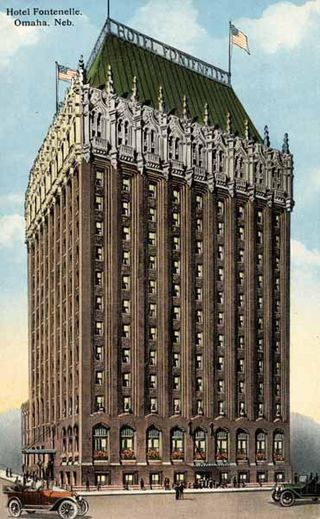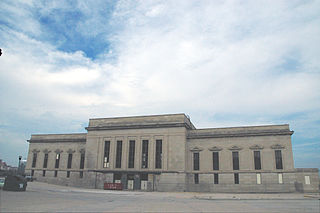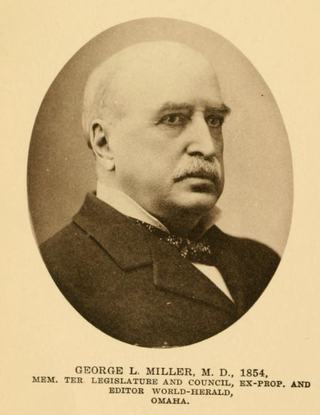Related Research Articles

Fort Omaha, originally known as Sherman Barracks and then Omaha Barracks, is an Indian War-era United States Army supply installation. Located at 5730 North 30th Street, with the entrance at North 30th and Fort Streets in modern-day North Omaha, Nebraska, the facility is primarily occupied by Metropolitan Community College. A Navy Operational Support Center and Marine Corps Reserve unit, along with an Army Reserve unit occupy the periphery of the 82.5 acres (33.4 ha) fort. The government deeded all but four parcels of the land to Metropolitan Community College in 1974.

The history of Omaha, Nebraska, began before the settlement of the city, with speculators from neighboring Council Bluffs, Iowa staking land across the Missouri River illegally as early as the 1840s. When it was legal to claim land in Indian Country, William D. Brown was operating the Lone Tree Ferry to bring settlers from Council Bluffs to Omaha. A treaty with the Omaha Tribe allowed the creation of the Nebraska Territory, and Omaha City was founded on July 4, 1854. With early settlement came claim jumpers and squatters, and the formation of a vigilante law group called the Omaha Claim Club, which was one of many claim clubs across the Midwest. During this period many of the city's founding fathers received lots in Scriptown, which was made possible by the actions of the Omaha Claim Club. The club's violent actions were challenged successfully in a case ultimately decided by the U.S. Supreme Court, Baker v. Morton, which led to the end of the organization.
The Miller Park neighborhood in North Omaha, Nebraska is a historically significant community housing a historic district and several notable historic places. It is located between Sorenson Parkway on the south and Redick Avenue on the north, Florence Boulevard on the east and 30th Street on the west. The Minne Lusa neighborhood borders on the north, and the Saratoga neighborhood is on the south. Fort Omaha borders the neighborhood on the west. Miller Park is the namesake park in the neighborhood, as well as the Miller Park Elementary School. In 2017, the Miller Park/Minne Lusa area was ranked as having the 2nd highest rate of homicides and other violent crimes out of 81 Omaha neighborhoods.
The Omaha Claim Club, also called the Omaha Township Claim Association and the Omaha Land Company, was organized in 1854 for the purpose of "encouraging the building of a city" and protecting members' claims in the area platted for Omaha City in the Nebraska Territory. At its peak the club included "one or two hundred men", including several important pioneers in Omaha history. The Club included notable figures important to the early development of Omaha. It was disbanded after a ruling against their violent methods by the U.S. Supreme Court in 1860 in Baker v. Morton.
African Americans in Omaha, Nebraska are central to the development and growth of the 43rd largest city in the United States. The first free black settler in the city arrived in 1854, the year the city was incorporated. In 1894 black residents of Omaha organized the first fair in the United States for African-American exhibitors and attendees. The 2000 US Census recorded 51,910 African Americans as living in Omaha. In the 19th century, the growing city of Omaha attracted ambitious people making new lives, such as Dr. Matthew Ricketts and Silas Robbins. Dr. Ricketts was the first African American to graduate from a Nebraska college or university. Silas Robbins was the first African American to be admitted to the bar in Nebraska. In 1892 Dr. Ricketts was also the first African American to be elected to the Nebraska State Legislature. Ernie Chambers, an African-American barber from North Omaha's 11th District, became the longest serving state senator in Nebraska history in 2005 after serving in the unicameral for more than 35 years.
The Lone Tree Ferry, later known as the Council Bluffs and Nebraska Ferry Company, was the crossing of the Missouri River at Council Bluffs, Iowa, and Omaha, Nebraska, US, that was established in 1850 by William D. Brown. Brown was the first pioneer to see the potential for a city on the site, and the landing became a popular gathering site for the first settlers of the Nebraska Territory. Named after a solitary tree on the Nebraska bank of the river, the Lone Tree Ferry became central to the founding and development of the City of Omaha.
William D. Brown was the first pioneer to envision building a city where Omaha, Nebraska sits today. Many historians attribute Brown to be the founder of Omaha, although this has been disputed since the late nineteenth century. Alfred D. Jones, the first postmaster of Omaha, laid strong claims to the title himself, suggesting that he told Brown about the potential for a town. Brown was also a member of the Second Territorial Legislature for the Nebraska Territory.

Alfred D. Jones was a late 19th-century lawyer, surveyor and politician in the Midwestern United States. In 1846 he platted Fort Des Moines, Iowa, and in 1854 he platted Omaha, Nebraska. He became the first settler in Omaha, as well as the first postmaster, a member of the first Omaha City Council and the first Omaha School Board, and was among the first legislators of the Nebraska Territory.

Transportation in Omaha, Nebraska, includes most major modes, such as pedestrian, bicycle, automobile, bus, train and airplane. While early transportation consisted of ferries, stagecoaches, steamboats, street railroads, and railroads, the city's transportation systems have evolved to include the Interstate Highway System, parklike boulevards and a variety of bicycle and pedestrian trails. The historic head of several important emigrant trails and the First transcontinental railroad, its center as a national transportation hub earned Omaha the nickname "Gate City of the West" as early as the 1860s.

Railroads in Omaha, Nebraska, have been integral to the growth and development of the city, the state of Nebraska, the Western United States and the entire United States. The convergence of many railroad forces upon the city was by happenstance and synergy, as none of the Omaha leaders had a comprehensive strategy for bringing railroads to the city.

Jesse Lowe was the first mayor of Omaha, Nebraska, serving for one year from March 5, 1857 to March 2, 1858. An important real estate agent in the early city, Lowe is credited with naming the city after the Omaha Tribe.

George Lorin Miller (1830–1920) was an American pioneer physician, editor, politician, and land owner in Omaha, Nebraska. The founder of the Omaha Herald, which later became part of the Omaha World-Herald, Miller arrived in Omaha in 1854, the year the city was founded. He also promoted Omaha as the route of the First transcontinental railroad and the Trans-Mississippi and International Exposition in Omaha in 1898.
Andrew Jackson Hanscom was a pioneer Omaha, Nebraska lawyer, politician and real estate broker.
James Gabriel Megeath was a pioneer in Omaha, Nebraska who is known for his helping found Hanscom Park, to which Megeath donated substantially.
Enos Lowe was a pioneer doctor and businessman who was among the original founders of Omaha, Nebraska and served as president of the Second Iowa Constitutional Convention.
The First Nebraska Territorial Legislature first met in Omaha, Nebraska, on January 15, 1855. The Council Bluffs and Nebraska Ferry Company provided the first meeting place, which was a building "constructed for public purposes". Standing out from the estimated twenty shacks in the young town, it was the first brick building in Omaha, which was founded the year before when the Nebraska Territory was created. Responsible for several important decisions that laid an important foundation for the future statehood for Nebraska, the Nebraska Territorial Legislature made controversial decisions and provided leadership for the territory.
Significant events in the history of Omaha, Nebraska, include social, political, cultural, and economic activities.
Walter J. Singleton was a journalist and civil servant in Omaha, Nebraska and Washington, D.C. He was an editor of the Omaha Progress and a member of the Afro-American League, a predecessor of the NAACP. In Washington D.C. he worked as a clerk for the Department of War and was active in a number of intellectual and social clubs.

Edwin R. Overall aka Edwin R. Williams was an abolitionist, civil rights activist, civil servant, and politician in Chicago and Omaha. In the 1850s and 1860s, he was involved in abolition and underground railroad activities headed at Chicago's Quinn Chapel AME Church. During the U. S. Civil War, he recruited blacks in Chicago to join the Union Army. After the war, he moved to Omaha, where he was involved in the founding of the National Afro-American League and a local branch of the same. He was the first black in Nebraska to be nominated to the state legislature in 1890. He lost the election, but in 1892, his friend Matthew O. Ricketts became the first African-American elected to the Nebraska legislature. He was also a leader in Omaha organized labor.
References
- ↑ Larsen, L.H., Cottrell, B.J., and Dalstrom, H.A. (2007) Upstream Metropolis: An Urban Biography of Omaha and Council Bluffs. University of Nebraska Press. p 76.
- ↑ "Chapter XXIX: Old Settlers" Archived 2007-06-08 at the Wayback Machine , Early History of Omaha. p. 214.
- ↑ "Chapter XXIX: Old Settlers" Archived 2007-06-08 at the Wayback Machine , Early History of Omaha. p. 214.
- ↑ Douglas County. Andreas' History of the State of Nebraska. Retrieved 9/17/07.